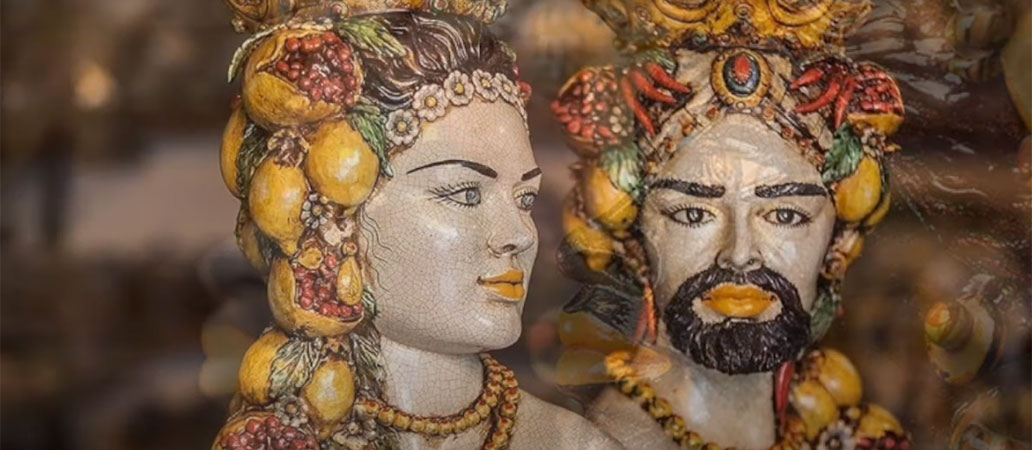
Sicily is famous for its glazed ceramics, among which the Moor's Heads stand out: vases always in pairs that reproduce a light-skinned woman and a dark-skinned man.
The Heads of the Moors are elegant vasi decorative ceramic hand painted which portray the face of a man and a woman, both embellished with jewels, flowers and citrus fruits. The dark brown heads, also known as “greasy” in Sicilian dialect, they tell a story of passion, betrayal, jealousy and revenge.
The legend of the Moor's head
La legend of the Moor's Head, is one of the best known and most fascinating of the Sicilian tradition. To tell the truth, there are two versions of the story. The first, of love and revenge, is the most popular; the second, less known and less folkloric, is perhaps the most plausible.
The most famous legend has it that around the year 1100, during the Arab domination in Sicily, a beautiful young woman lived in the Kalsa district of Palermo, the Arab quarter.
The girl rarely went out and preferred to spend her days taking care of the plants that adorned the splendid balcony of her home.
One day, while walking in the neighborhood, a young Moor saw the girl watering the plants and fell in love with her instantly.
Il Moro immediately entered the girl's house and, without delay, declared his love for her. Even the young woman, touched by the dark man's ardent and intense declaration, fell madly in love with her.
The secret of the young Moor and revenge
The young Moor was hiding a secret: he would soon have to return to the East and, moreover, in his homeland there would have been a family waiting for him, made up of his wife and children.
The young Palermitan discovered how much the Moor had kept hidden to conquer her and blinded by jealousy and wounded pride, she planned an act of cruel revenge.
In fact, he decided to kill his beloved during his night's sleep to prevent him from returning to his family in the East. But killing him wasn't enough. The betrayed girl cut off the Moor's head to always keep it with her.
The Moor's head became a vase
The girl cut off the young man's head and made a vase where she planted one basil plant.
He chose basil, known in popular tradition asherb of kings, just to symbolize her devotion to her beloved who would forever remain the ruler of her heart.
The basil grew abundantly thanks to the tears that the girl shed every day.
The inhabitants of the neighborhood, envious and enraptured by the extraordinary beauty of the plant and its delicious scent, began to decorate their balconies with terracotta vases that bore the appearance of the severed head of the young Moor.
The alternative version of the legend of the Moro's Head
In addition to the one just mentioned, a different version of the same legend, however, tells of a Sicilian girl of noble origins who had undertaken a clandestine relationship with a young Arab.
Love was soon discovered and the two were beheaded. The heads of both were turned into vases and placed on a balcony so that all might know the shame of that love.
From legend to work of art
Today the Moorish heads are still very much spread in Sicily: they can be found, in pairs and of various sizes, black or white and generously decorated, displayed on balconies, along streets but also inside houses as ornaments and decorative pieces.
Precisely by virtue of their history, the Teste di Mori have become the symbol of Sicilian craftsmanship in the whole world. These extraordinary and iconic vases are created, shaped and painted by the hands of master craftsmen in city shops such as Caltagirone e Santo Stefano di Camastra, centers of excellence for the art of pottery in Sicily.
Refined furnishing accessories for indoor and outdoor spaces, the Teste di Moro adapt not only to environments decorated in a classic, Sicilian or Arab style, but also to minimalist and elegant environments, especially if boldly combined with contemporary design pieces.
Artistic representations of a story of love, jealousy and revenge that has become legend, the Moro Heads enchant with their charm and magical appearance. In addition to serving as vases, they can be used for more creative purposes (umbrella stands, table bases, etc.), as home accessories or decorative outdoor sculptures.
Their beauty has also been a source of inspiration for the fashion world, making these singular works of art famous all over the world.









